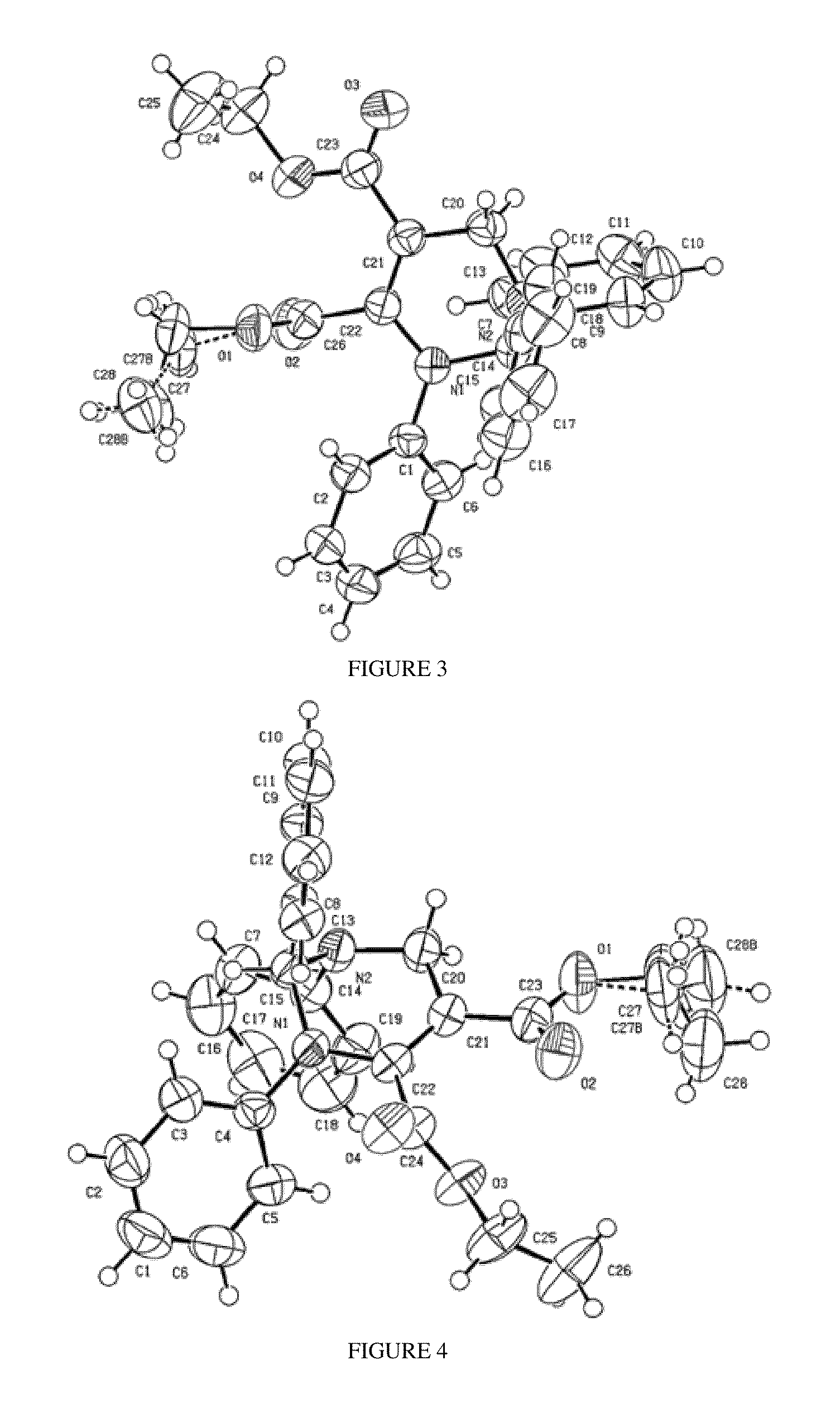Penta-substituted tetrahydropyrimidines with aggregation-induced emission characteristics and preparation method and use thereof
a technology of tetrahydropyrimidine and aggregation, which is applied in the field of pentasubstituted tetrahydropyrimidines with aggregation-induced emission characteristics and preparation methods, can solve the problems of reducing or even quenching fluorescence, affecting the luminous efficiency of organic fluorescent substances and the service life of oled, and reducing the accuracy of methods used for quantitative analysis, so as to achieve strong ai
- Summary
- Abstract
- Description
- Claims
- Application Information
AI Technical Summary
Benefits of technology
Problems solved by technology
Method used
Image
Examples
example 1
(1) 1 mmol (170 mg) of diethyl acetylenedicarboxylate and 1 mmol (93 mg) of aniline were successively added into 2 mL of ethanol, which was then stirred at room temperature by 20 min.
(2) 2 mmol (186 mg) of aniline, 2 mmol (160 mg) of aqueous formaldehyde (30% wt %) and 2 mmol (120 mg) of acetic acid were added into 2 mL of ethanol, which was then stirred at 40° C. by 20 min.
[0047]The solutions obtained by (1) and (2) were mixed, and then added with 2 mmol (212 mg) of benzaldehyde and 0.1 mmol (6 mg) of urea at 40° C. After 48 h of reaction, 20 mL of saturated aqueous sodium chloride was added. Then extraction with 20 mL of dichloromethane was repeated 3 times. The dichloromethane solutions were mixed and then extracted with 20 mL of saturated aqueous sodium chloride by 3 times. The resulting dichloromethane solution was dried with magnesium sulfate, and then subjected to distillation under reduced pressure to remove the solvent. The product was purified by preparative layer chromato...
example 2
(1) 1 mmol (170 mg) of diethyl acetylenedicarboxylate and 1 mmol (107 mg) of benzylamine were successively added into 1 mL of N,N-dimethylformamide, which was then stirred at room temperature by 10 min.
(2) 1 mmol (107 mg) of benzylamine and 1 mmol (80 mg) of formaldehyde (30%) were added into 2 mL of N,N-dimethylformamide, which was then stirred at room temperature by 10 min.
[0049](3) The solutions obtained by (1) and (2) were mixed, and then added with 1 mmol (106 mg) of benzaldehyde and 0.5 mmol (55 mg) of proline at 80° C. After 24 h of reaction, 20 mL of saturated aqueous sodium chloride was added. Then extraction with 20 mL of dichloromethane was repeated 3 times. The dichloromethane solutions were mixed and then extracted with 20 mL of saturated aqueous sodium chloride by 3 times. The resulting dichloromethane solution was dried with magnesium sulfate, and then subjected to distillation under reduced pressure to remove the solvent. The product was purified by preparative layer...
example 3
(1) 1 mmol (170 mg) of diethyl acetylenedicarboxylate and 1 mmol (107 mg) of p-toluidine were successively added into 1 mL of n-hexane, which was then stirred at room temperature by 1 h.
(2) 5 mmol (107 mg) of p-toluidine and 3 mmol (240 mg) of formaldehyde (30%) were added into 10 mL of dichloromethane, which was then stirred at room temperature by 10 min.
[0051](3) The solutions obtained by (1) and (2) were mixed, and then added with 5 mmol (530 mg) of benzaldehyde and 0.5 mmol of copper acetate at room temperature. After 36 h of reaction, 20 mL of saturated aqueous sodium chloride was added. Then extraction with 20 mL of dichloromethane was repeated 3 times. The dichloromethane solutions were mixed and then extracted with 20 mL of saturated aqueous sodium chloride by 3 times. The resulting dichloromethane solution was dried with magnesium sulfate, and then subjected to distillation under reduced pressure to remove the solvent. The product was purified by preparative layer chromatog...
PUM
| Property | Measurement | Unit |
|---|---|---|
| wavelength | aaaaa | aaaaa |
| aggregation-induced emission | aaaaa | aaaaa |
| aggregation-induced emission characteristics | aaaaa | aaaaa |
Abstract
Description
Claims
Application Information
 Login to View More
Login to View More - R&D
- Intellectual Property
- Life Sciences
- Materials
- Tech Scout
- Unparalleled Data Quality
- Higher Quality Content
- 60% Fewer Hallucinations
Browse by: Latest US Patents, China's latest patents, Technical Efficacy Thesaurus, Application Domain, Technology Topic, Popular Technical Reports.
© 2025 PatSnap. All rights reserved.Legal|Privacy policy|Modern Slavery Act Transparency Statement|Sitemap|About US| Contact US: help@patsnap.com



